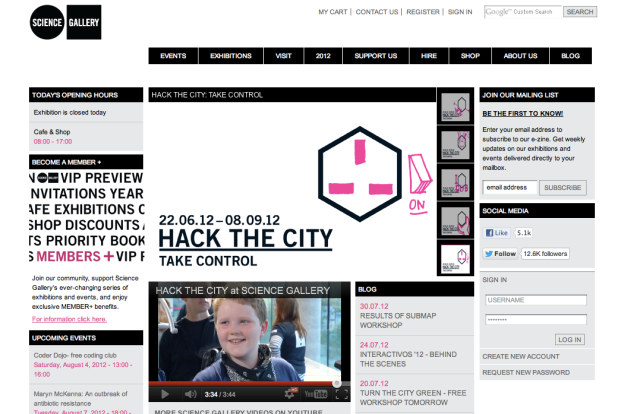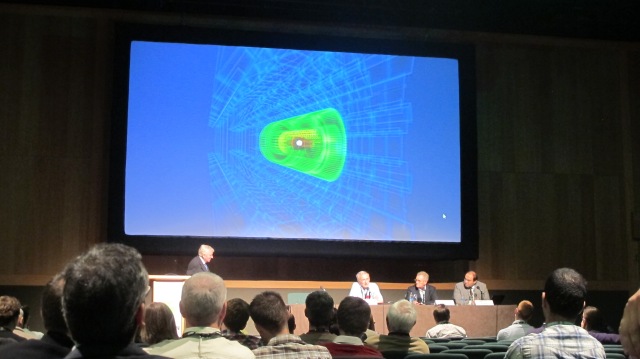Talk 12 – 14.07.12 – Can Europe Save the Pharma Industry?
 Luke O’Neill (Academic Director of the Trinity Biomedical Sciences institute) opened this debate proposing the question, if the Pharma industry is broken and if it’s best to just manage its decline. He highlighted the job losses that are occurring in the industry across europe and the recent scandals from a drug companies.
Luke O’Neill (Academic Director of the Trinity Biomedical Sciences institute) opened this debate proposing the question, if the Pharma industry is broken and if it’s best to just manage its decline. He highlighted the job losses that are occurring in the industry across europe and the recent scandals from a drug companies.
The model of IP protection has failed, with the proliferation of generic drugs. Developing and discovering new drugs is a high risk strategy, with the cost of $2 billion to bring a new product to market. Big pharma has started to outsource discovery part of the supply chain. There is a massive opportunity for academia to respond to this need, but will it be a partnership and will academia be able to meet the demands and pace of the fast moving industry.
The testing phases can be highly irregular and if phase three of testing fails; the patients are wrong, as not everyone responds the same way. In these situations better patient profiling is required. In this environment of personalised diagnostics, every disease will be an orphan disease. But diagnostics and therapeutics combination is currently really expensive and the chance of misinterpretation is quite high.
Biology is next grand challenge for science, there is a general human template to analyze with massive variation. Due to improved medication, Aids is no longer a deadly disease but a chronic one, if the medication is readily available. I wondered if there is motivation to develop preventative vaccines, as the long-term use of drugs makes will create more revenue than a once off vaccine?
It was questioned from the audience if R&D of Pharma companies are focusing on providing solutions beyond drugs that relate to well being and health of patients. I believe there will always be a resistance to alternative therapies, as the business model does not favor watering down the dependencies that are created.
Can europe save Big Pharma? is it their duty too? is this a natural transition and would any intervention create an artificial stabilizing on an industry that can no longer grow at its previous rates.
Talk 13 – 14.07.12 What does Art bring to Science?
This event was organised Michael John Gorman of the Science Gallery, Dublin. Creativity brings provocation, dialogue and critique; artists pose questions, like – What if?
The Science Gallery have run a number of exhibitions since their inception that bring together the intrigue of art and the pursuit of knowledge that drives science. Some of these have been, Victimless leader, What If?, Infectios, Happy?, They explore immediate themes that bring these questions closer to people’s lives.
Michael John Gorman noted that the term scientist is a nineteenth century invention, scientists used to be amateurs and do it for the love of it. The world is creating new roles in society that are neither art nor science, so how will our education system adapt to this demand?
Clare Matterson spoke from the ‘Welcome Collection London’, their role is to fund art science collaborations. Many are playful, creating games to understand international trading to provoke intrigue in the fourteen year old plus bracket. It was questioned if there is a greater benefit to arts than science in these collaborations? Clare insisted that it’s not about dumbing down Science, it’s about leading us into exiting new places of understanding. Art working with science can accelerate challenge and curiosity driven enquires by asking the awkward questions of What If and Why Not?
Talk 14 – 14.07.12 – The search for a deeper understanding of our universe at the large hadron collider: The world’s largest particle accelerator
Rolf-Dieter Heuter is the Director General of CERN
Rolf-Dieter Heuter is the Director General of CERN who was recently involved in discovering what is probably the ‘Higgs Boson’, the smallest particles that are known to man. In 1989, CERN unintentionally invented the World Wide Web for researchers to share information more easily with one another.
The Hadron Collider is the largest instrument ever built, creating temperatures that are hotter than the centre of the sun, and the coldest place on earth to replicate the conditions at the first moment of the big bang. The Higgs Particle is a self-interacting particle, the collider has helped them identify this property by analyzing matter behavior and anti-matter behavior. They hope that this discovering will understand what 96% of the universe is made off. The applications of this research are not yet understood.
They first had to claim to see old stuff before recognizing new stuff and this was like ‘identifying snowflakes in a big snowfall in front of a snowfield’.
Section of collider showing a collision
Cern have employed Artists in residence at the research facility and they reckon that they will be “Inspired for ten years at least.” One thing is certain that our understanding of the universe is about to change.
Talk 15 – 14.07.12 – What do investors look for in Business Propositions?
Dublin Business Innovation Centre
This talk was organised by John Phelan of the Dublin Business Innovation Centre, the purpose of it was to bring entrepreneurs in contact with investors to give them an opportunity to make a pitch and gain some insights in what they might look for in an investment. I attended this conference as I thought I might be in a position to make a pitch in the future and I wanted to understand how it could be done.
Brigette Baumann, an angel investor and founder of Go Beyond Ltd. broke down her criteria into three parts:
- Individuals
- The Business
- Deal structure, who else is involved.
The team was considered very important, as they don’t change but the business model can be modified. She will then identify the problem they are trying to solve and how are they solving this problem. Is it project financing or equity? What is the life cycle till it runs on it’s own. Relationships were considered very important, ‘we need to be able to work together and understand the different vision of the investors’. Thierry Baujard of Pan Europena investment network put his criteria as, ‘What is the IP creation? and what will be the exit strategy?’.
At the outset of the talk, the chairman of Dublin innovation centre introduced the esteemed panel the presenters. He then made a request to the audience to see if there was a women entrepreneur who would be willing to make an elevator pitch to panel. My heart fluttered wondering should I take the leap, but I never thought I would be able to do it. Some men’s hands went up, but the Chairman said that they prefer to have a women. With a nod of encouragement from my Fiancé, I volunteered, to applause and encouragement from the audience for my bravery at stepping up to the mark. The fact that I’m looking for work and opportunities made me bite the bullet without realising and considering what might go wrong.
I took the microphone, introduced myself to eighty delegates and told them what I would talk about. My turn was last, so I had forty-five minutes to think and jot a few notes down before I would do my pitch. Unfortunately, my mind was so busy constructing what I would say, I barely took in what the other entrepreneurs were pitching. Within ten minutes I had jotted down all the points I wanted to talk about and felt confident that I could get across my idea.
Taking the floor to make elevator pitch
Without a chance to worry, my time came to take the floor, without visual cues or a prepared script. I gave the audience and the investors an overview of the team, the problem and business opportunity, how it worked, the business model, what was required for next stage, and what difference it would make to have it. The presentation flowed, sometimes in those moments of pressure, the words come, but this cannot be always guaranteed if no preparation is done.
It was great to get feedback from the investors and questions from the audience, who made great points that could be incorporated into the product. The risk of opening up an idea at an early stage of development is that someone might ‘steal’ it. But there is also so much to be gained form sharing and building on those ideas. Sometimes, working on your own in a small team of two can be quite isolating. Bringing the ideas out into the public, tests their validity and the receptivity to them. I’m glad I got up and spoke, but that was the easy bit! The challenge now is to bring the disparate information together to make a workable prototype that can tested and improved upon.
Sometimes you get luck at the beginning of a hard journey to encourage you to continue on the challenging path.








